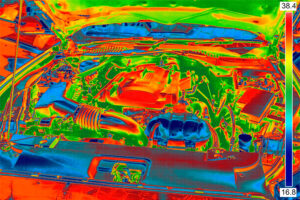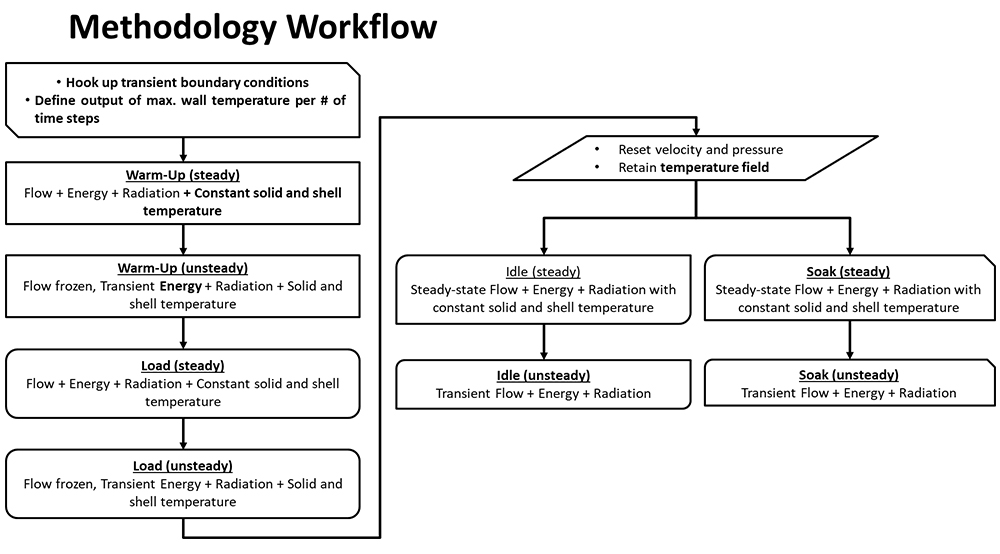Automotive thermal management is an important analysis tool to optimize the performance and safety of cars — especially in an era of electrification.

As more and more heat-sensitive electronics like battery packs and inverters are added to cars, the more susceptible they will be too hot climates and high loads.
Traditionally, computational fluid dynamics (CFD) has offered engineers an accurate and quick option to study these cars under steady-state conditions. However, the exorbitant amount of processing power that is required to model a car’s heat map during transient conditions is a considerable industry challenge.
The lack of a practical high-fidelity temperature analysis tool during transient conditions means that engineers are unable to assess how sudden thermal impacts can affect their designs. However, a clever practice using ANSYS Fluent can help engineers assess the risks of these thermal impacts.
The Challenges of Simulating Transient Automotive Thermal Management Scenarios
Traditionally, CFD analysis of a transient automotive thermal management scenario requires a time step on the order of 0.1 ms, or smaller, to remain stable.
With each time step needing a series of iterations to converge and a total transient analysis time of an hour, it’s no wonder why these analyses require an excessive amount of computational power.
Some strategies have been created to help reduce the computational requirements to test these scenarios, such as:
- Using a coarser mesh
- Lowering the air’s flow–thermal coupling frequency
- Using pseudo-transient modeling to temporarily decouple the air flow and thermal field
Unfortunately, the model’s fidelity suffers from these simplifications.
How to Quickly Simulate Transient Automotive Thermal Management Scenarios
An alternative method takes advantage of the disparate thermal time constants of the air and the solids within and around the car. These constants show how sensitive the air and solids are to thermal changes in the system. It turns out that the air responds to thermal changes two orders of magnitude faster than the solids.

Since a sudden step change will affect the air flow in a fraction of the time it will change the car’s surface, there is no need to capture the small temporal fluctuations within the flow. This means that engineers can get away with a larger time step and coarser mesh in the flow.
Additionally, engineers can separate every transient automotive thermal management scenario into two steps: a steady-state step followed by a transient step. This setup was used to assess a vehicle during various conditions, including:
- Warmup
- Loading
- Soak (park with engine off)
- Idle (park with engine on)
In the steady-state step, the flow field is independently determined based on the initial boundary conditions and thermal conditions of the car. The transient step consists of a decoupled energy transfer simulation. The energy transfer simulation assumes that forced convection is dominant during warmup or loading, and a conjugate heat transfer approach is dominant when the car is idle or soaking.
With the flow solution effectively instantaneous — compared to the solid body of the car — the car’s transient analysis can be simplified into an energy problem. Within Fluent, this can be solved with a surface-to-surface radiation model using pure convection and conduction.
Benefits of this New Method to Assess Transient Automotive Thermal Management Scenarios
With the proposed simplified method, engineers increased the simulation time step from a fraction of a millisecond to seconds. As a result, all of the transient automotive thermal management scenarios were assessed within 11 hours. The model consisted of 68 million elements in a tetrahedral mesh.

For example, assessing the car during soak saw a 10X speedup compared to a fully coupled transient analysis with a time-dependent timestep.
Engineers assessing these transient thermal scenarios are typically working with non-watertight geometry. To learn of ways to mesh these geometries quickly, read about ANSYS Fluent task-based workflows.
This blog was originally posted on ANSYS’ website .




